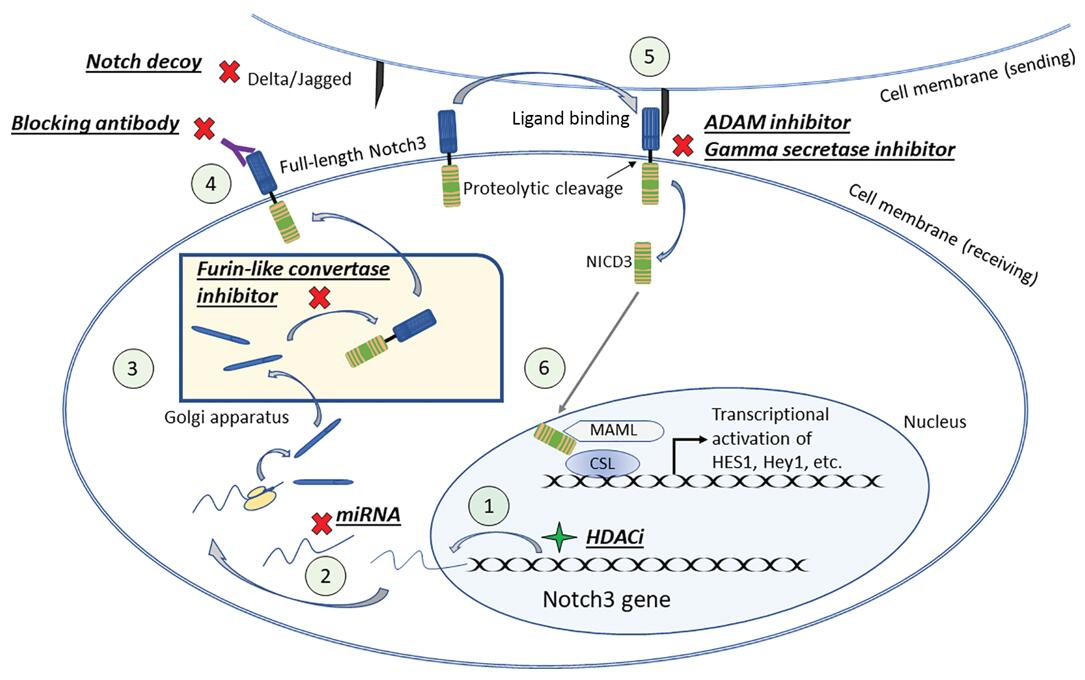
Our promise to you:
Guaranteed product quality, expert customer support.
 24x7 CUSTOMER SERVICE
24x7 CUSTOMER SERVICE
 CONTACT US TO ORDER
CONTACT US TO ORDER
Notch3 Gene Editing 
Notch signaling plays a fundamental role in normal development. Notch receptors (Notch 1–4) are transmembrane proteins that signal by binding with their ligands, Jagged and Delta-like families. After binding, Notch receptor undergoes proteolytic cleavages, leading to the release of the Notch intracellular domain (NICD), which translocates to the nucleus and drives the expression of downstream targets such as c-Myc, Akt, Hes1, Hey-1.
The Roles of Notch3 in Cancer
The Notch signaling pathway is associated with numerous human malignancies. In particular, Notch3 pathway dysregulation is usually related to the pathogenesis and progression of several tumors. It has been proven to affect tumor aggressiveness, maintenance, and resistance to chemotherapy. Activation of Notch pathways results in increased expression of various downstream targets, some of which include transcriptional regulators. According to the tissue type, Notch‐regulated transcriptional targets may conceivably be oncogenes or tumor suppressors. For example, it has been shown that Notch3 can act as oncogene in breast cancer, but may also lead to cell cycle arrest and prevent cellular proliferation.
Aberrant Notch signalling was first linked to human cancer by identifying a chromosome translocation, in T-cell acute lymphoblastic leukaemia (T-ALL), that led to the expression of the soluble cytoplasmic domain of Notch1, which was constitutively active, linking ectopic Notch activity to cancer progression. Many different factors are reported to drive high Notch3 expression in T-ALL. Activated Notch1 signalling has been proven to drive Notch3 expression, but high Notch3 also exists in T-ALL without activating Notch1 mutations. Recent studies have implicated Notch3 acting in a self-sustaining feedback loop to maintain its high expression combined with reduced histone3 (H3) K27 methylation, increased H3K4 methylation and K27 acetylation of the Notch3 enhancer region, which is an activated gene expression profile. In T-all cells miR-150, normally highly expressed in the lymphoid lineage, is reduced in expression and this loss may therefore contribute to increased Notch3 levels as has also been found in ovarian cancer and lung adenocarcinoma.
Notch3 As a Therapeutic Target
Targeted therapies can be used to change Notch3 levels in the cells. Gamma secretase inhibitors have been used to inhibit Notch activity in cancers with high Notch expression, but they are not specific to Notch subtypes. Additional putative targets inhibiting Notch enzymatic processing include Furin‐like convertase and ADAM inhibitors. To improve the specificity and avoid side effects of pan‐Notch blockade, one study used monoclonal antibodies (tarextumab) to block Notch2/Notch3. MicroRNAs targeting specific Notch subtypes have been used for inhibition, including miR‐136 and miR‐206 targeting Notch3. Moreover, targeting the Notch/Jagged or Notch/Delta interaction is another route for potential therapeutic development. In cases in which Notch3 is responsible for regulating tumor suppressor genes, it would be beneficial to induce Notch3 expression rather than inhibit it. Several histone deacetylase inhibitors have been shown to increase Notch expression in multiple neuroendocrine tumor cells in which Notch plays a tumor suppressive role. These histone deacetylase inhibitors were shown to increase NICD3, induce apoptosis, inhibit tumor growth, and decrease tumor marker secretion.
 Figure 1. The Notch pathway, showing therapeutic points for targeting Notch3. (Aburjania Z, et al., 2018)
Figure 1. The Notch pathway, showing therapeutic points for targeting Notch3. (Aburjania Z, et al., 2018)
Notch3 Gene Editing Services
CRISPR/Cas9 PlatformCB at Creative Biogene is dedicated to offering comprehensive CRISPR/Cas9 gene editing services and products for academic research, biotech research and pharmaceutical drug discovery. With deep gene editing knowledge and extensive experience in experimental operation and data processing, we help you effectively control NOTCH3 genes knockout/knockin/point mutation in cells or animals via CRISPR/Cas9 technology.
| Service | Details | Alternative cell lines or animal species |
| NOTCH3 Gene Editing Cell Line Generation | gRNA design and synthesis Transfect the cell lines you're interested Select the high expression cells and sort monoclonal cell Validate the knockout/knockin/point mutation of NOTCH3 by PCR and sequencing Provide cryogenically preserved vials of stable cells and final reports | HEK239T, Hela, HepG2, U87, Ba/F3, CHO, MDA-MB-453, MDA-MB-231NIH3T3, T47D, Neuro2a, MCF7, RKO, K562, RAW264.7, etc. |
| NOTCH3 Gene Editing Animal Model Generation | NOTCH3 gene conventional knockout animals NOTCH3 gene conditional knockout animals NOTCH3 point mutation animals NOTCH3 knockin animals | Mouse, rat, rabbit, zebrafish, C. elegans, etc. |
Related Products at CRISPR/Cas9 PlatformCB
| CATALOG NO. | PRODUCT NAME | PRODUCT TYPE | INQUIRY |
| CDKM-0549 | B6J-Notch3em1Cflox | Knockout Mouse | Inquiry |
| CLKO-1312 | NOTCH3 KO Cell Lysate-HEK293T | Knockout Cell lysate | Inquiry |
| CSC-RT1462 | Human NOTCH3 Knockout Cell Line-HEK293T | Pre-Made Knockout Cell Line | Inquiry |
References
- Hassan W A, et al. Evaluation of role of Notch3 signaling pathway in human lung cancer cells. Journal of cancer research and clinical oncology, 2016, 142(5): 981-993.
- Ceccarelli S, et al. Notch3 targeting: a novel weapon against ovarian cancer stem cells. Stem Cells International, 2019, 2019.
- Aburjania Z, et al. The role of Notch3 in cancer. The oncologist, 2018, 23(8): 900-911.
- Hosseini-Alghaderi S, Baron M. Notch3 in development, health and disease. Biomolecules, 2020, 10(3): 485.